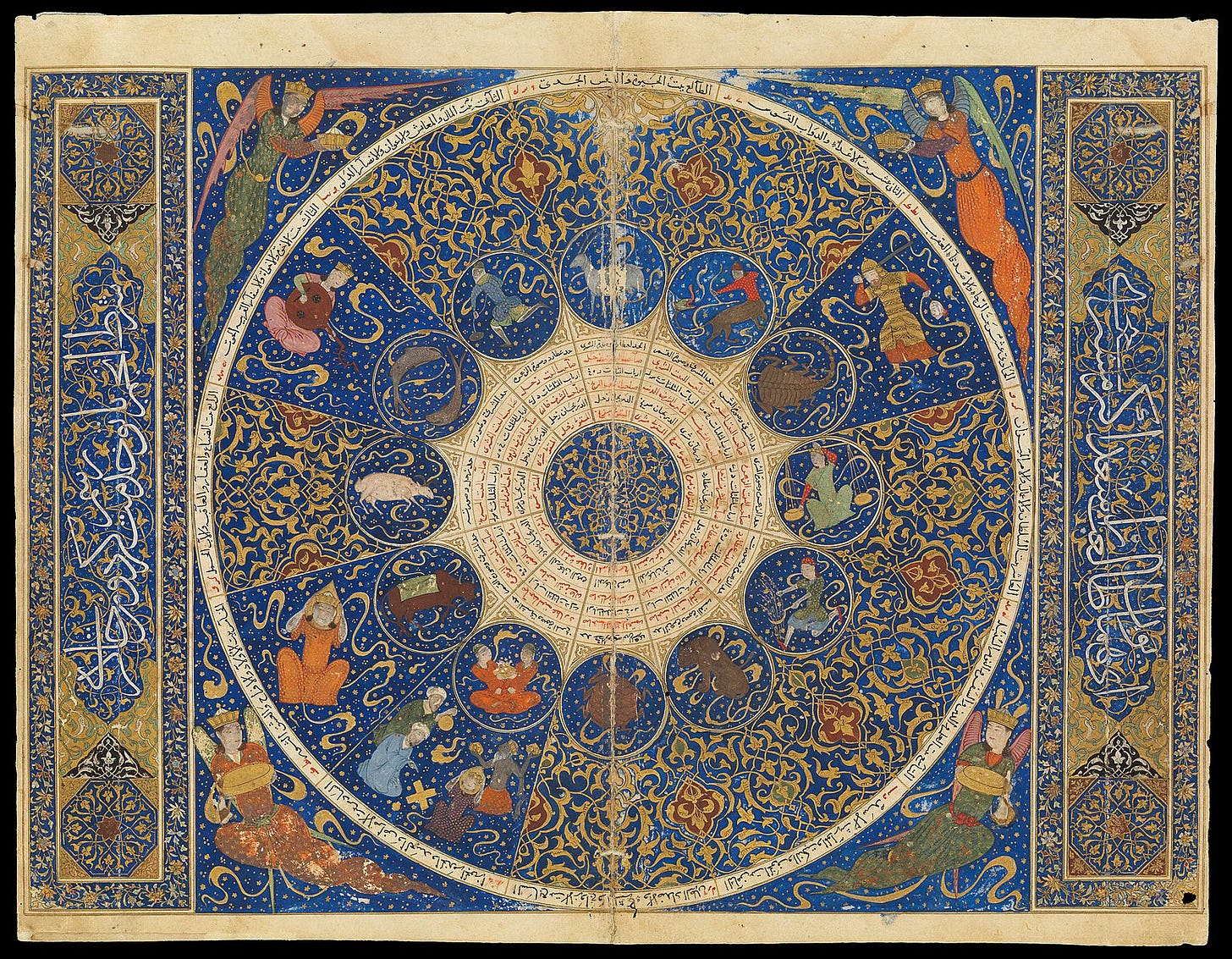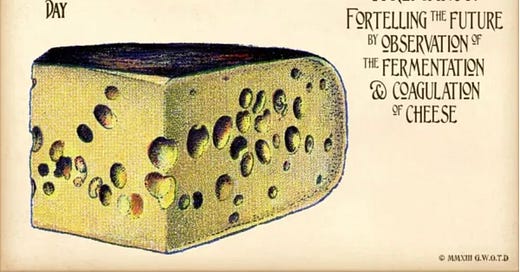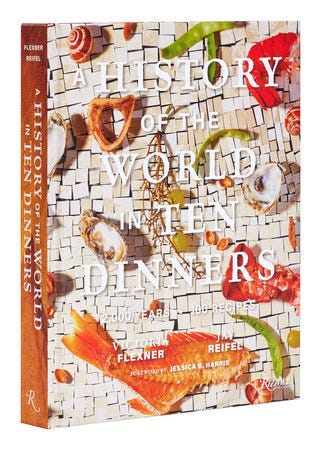A couple months ago I was having lunch with a friend who is studying to be a Master of Cheese. Yes, one can now become an accredited Master of Cheese – sort of like a sommelier, but with well, cheese. In her studies, she had come across Jennifer Billock, a Chicago-based writer and Tyromancer, who tells fortunes through cheese. My friend had recently done a reading with Billock and said it was totally fascinating. So naturally, I booked a session.
Over Zoom, Billock told me about my past, present and future by interpreting the lines, cracks, shapes, mold patterns, and images on three different pieces of cheese that had been selected for my reading. My past and present readings were surprisingly accurate. TBD on the future. If, like me, you lean towards the witchier things in life, I highly recommend booking yourself a tyromancy session.
But despite my subscription to the CHANI app, and my TikTok algorithm serving me up a steady stream of astrological predictions for what Pluto’s transition into Aquarius will mean for America this November — food divination was not a subject I had given much previous thought to.
Reading the tea leaves. Looking deep into the coffee grinds (or cheese), these are very old traditions. Tasseomancy, the art of fortune telling by interpreting patterns in tea leaves, coffee grinds or wine sediments, has been practiced throughout Asia, the Middle East and Europe since ancient times. In the same way we sometimes see shapes or figures in the clouds, the idea with Tasseomancy is that the patterns, symbols and images left behind in the glass or cup can be read and interpreted. The shape of a bird might symbolize a new journey. Letters might relate to the name of someone in your life. An image close to the rim of the cup symbolizes something in your past; an image at the bottom of your cup shows something in your future.
As tea consumption spread from China to the rest of the world in the 16th and 17th centuries, the art of tasseomancy spread with it. In the United Kingdom particularly, Victorian occult fascination found new life in the reading of tea leaves and became a popular parlor activity. In 1881, an author named only as “A Highland Seer” wrote one of the oldest English texts on the subject, Reading Tea Leaves. The manuscript includes a whole dictionary on the meanings of various symbols, as well as illustrated examples of different cup patterns. As I was reading the introduction, written 140 years ago, I couldn’t help but chuckle:
“It seems highly probable that at no previous period of the world's history have there been so many persons as there are at the present moment anxious to ascertain in advance, if that be humanly possible, a knowledge of at least what a day may bring forth…a perfectly sane and natural curiosity…a desire to employ any form of divination in the hope that some light may haply be cast upon the darkness and obscurity of the future.”
Perhaps it’s not so much funny, as it is deeply familiar. The day before I’d stumbled across a page on Tasseomancy on the Twinings’ site. Yes, the Twinings tea company has a section on their website called, “The Basics of Reading Tea Leaves” because,
“Modern living can be demanding and we’d all like to be able to see what lies ahead. Superstitious people see omens and signs all around them and it is an ancient human instinct to want to understand the universe. As such, people have always looked to fortune tellers, prophets and mystics to make sense of the world and to give some guidance to their lives.”
A step-by-step guide explaining how to read your own tea leaves is provided — as are a selection of Twinings teas that would be ideal for such an activity. Yes, it’s a corporate website. And whoever wrote this copy did so with the goal of slinging tea. But there is truth in the New Age marketing.
Life is unpredictable and the future is unknown. A supreme irony for us human beings. Creatures, who for the most part, crave stability.
As long as humans have been around, we’ve been trying to find answers to the big questions. The search for these answers has led beyond the cup and the glass – to the sun, the moon and the stars. Astrology is a much older practice than tasseomancy. Cultures and societies across the globe have been looking to the sky for answers for millennia.

In the 8th century, when Caliph al-Mansur wanted to build his new capital Baghdad – he consulted a trio of stargazers. Making sure to cover all his bases, al-Mansur sailed down the Tigris River with a Jewish, Christian and Zoroastrian astrologer – seeking their guidance in determining the best spot upon which he should construct his city.

Queen Elizabeth I had her own court astrologer, a man named John Dee. Not only did Dee regularly consult the queen on auspicious dates and make forecasts based on the movements of the stars – he was also the first person to use the term “British Empire.” He authored the influential text Brytannicæ Republicæ Synopsis (Summary of the Commonwealth of Britain) in which he presented the problems facing the nation, and explained how expansionist maritime strategies would provide solutions. The fact that an astrologer might have provided the spark that led to the British Empire is too much for my mind to make sense of this Wednesday morning.
Catherine de Medici, the 16th century Queen of France, consulted one of the most famous astrologers of all time, Nostradamus. The famed Renaissance astrologer not only predicted the death of Catherine’s husband, King Henry II – but also (apparently) the French Revolution, the rise of Hitler, and 9/11 – all from his 16th century perch.
Centuries later, French president Charles de Gaulle would regularly consult an astrologer, a fellow soldier named Maurice Vasset. The two met in Toulon in 1944, after Vasset had studied astrology in Dakar while he was recovering from an injury. De Gaulle continued to consult Vasset before making big decisions right up until his resignation in 1969. Francois Mitterand also worked with an astrologer throughout his presidency (though his astrologer, a woman named Elizabeth Teissier, was rumored to have been more than just his stargazer). Benson Bobrick, who has written about the history of astrology in his book The Fated Sky, says that Theodore Roosevelt kept a copy of his birth chart on his desk and that Ronald Reagan consulted an astrologer before every major decision of his presidency.
Over the weekend I made a cup of rose and jasmine tea. I sat in the afternoon sun and sipped the warm floral notes. As I got to the bottom of my cup, I stopped and observed the patterns the flowers and tea leaves had made. A little clump here and there, some strands climbing up the sides. I thought about pulling out the Highland Seer’s guide and attempting to decipher what lay in the cup. But the sunshine was perfectly warm and I was comfortable right where I was. Maybe next time I’ll look for some answers.
Edible History is a reader supported newsletter. To support my work and gain access to the full archive of posts consider upgrading to become a paid subscriber.
Like what you’re reading? Get a copy of my book, A History of The World in Ten Dinners (Rizzoli) available here and here.









Cheese is good so wy not take advantage if it to find out my future.
Okay this is totally cool and interesting and of course now I’m pining for a cheese reading as I’m tired of the same TikTok tarot algorithm.